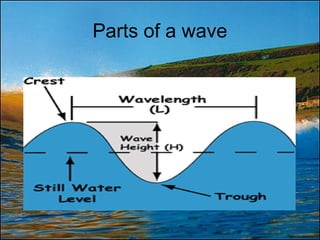Ocean waves are dynamic forces sculpting Earth’s vast waters that come in diverse forms and sizes from wind-driven ripples to large weather events, their presence shapes coastlines and impacts marine life. What are the different types of ocean waves?
- Wind Waves: Formed by wind transferring energy to the ocean surface.
- Tidal: Result from gravitational forces of the moon & sun.
- Tsunamis Waves: Triggered by seismic events-earthquakes/volcanic events.
- Capillary Waves: Small ripples influenced by surface tension.
- Gravity: waves driven by gravity, often wind.
Introduction:
Ocean waves are dynamic and ever-present features of Earth’s vast bodies of water. These waves play a crucial role in shaping coastlines, influencing weather patterns, and even impacting marine life. In this exploration, we will delve into the diverse world of ocean waves, understanding their classifications, formations, and the forces that drive them.
Different Types of Ocean Waves
Formation of Ocean Waves
The formation of Ocean Waves includes:
- Wind Energy Transfer:
- As wind blows across the surface of the ocean, it transfers energy to the water.
- This energy transfer occurs due to the friction between the moving air molecules and the water’s surface.
- Creation of Ripples:
- Initially, the wind creates small ripples on the water’s surface, known as capillary waves.
- These capillary waves are less than 1.74 cm in wavelength and are influenced by surface tension.
- Wave Growth:
- If the wind continues to blow, it imparts more energy to the water, causing the capillary waves to grow in size.
- The growing waves merge and combine, forming larger waves.
- Fetch:
- The distance over which the wind blows across the water’s surface is called “fetch.”
- The longer the fetch, the more time and space the wind has to transfer energy to the water, resulting in larger and more developed waves.
- Wave Height and Period:
- The energy from the wind creates variations in the water’s surface, forming waves with crests and troughs.
- The height of the waves (wave height) and the time it takes for one complete wave to pass a point (wave period) depend on factors such as wind speed, duration, and fetch.
- Wave Steepness:
- Wave steepness is the ratio of wave height to wavelength. It determines the shape and stability of the waves.
- If the wind continues to blow, the waves can become steeper and more organized.
- Wave Breakers:
- In shallow water near the coastline, waves experience friction with the ocean floor, causing them to slow down.
- As the waves slow down, their crests become steeper and may eventually break, leading to the familiar crashing of waves on the shore.
- Ocean Swell:
- If the wind consistently blows over a large area of the ocean, it generates organized groups of waves called swells.
- Swell waves can travel long distances across the open ocean, maintaining their energy and form.
Understanding the process of wind-induced wave formation is essential for predicting ocean conditions, studying coastal erosion, and comprehending the intricate relationship between the atmosphere and the oceans. It also plays a significant role in various fields, including marine navigation, offshore engineering, and coastal management.
An ocean wave is made up of two main parts, the wave crest and the wave trough. The wave crest is the highest point in the wave while the wave trough is the lowest part of the wave. The energy moving through the water causes the rise and fall of the water molecules.
Often seen at the beach, waves tend to travel in groups rather than alone. These groups are called wave trains.
Properties of Ocean Waves
The Properties of Ocean Waves include:
-

Parts of an Ocean Wave Wave Height: Vertical distance between a wave’s crest and trough.
- Wavelength: Horizontal distance between successive crests or troughs.
- Wave Period: Time for one complete wave to pass a point.
- Frequency: Number of waves passing a point per unit of time.
- Wave Amplitude: Half of the wave height, measuring from the still-water level.
- Wave Velocity: Speed at which a wave crest advances.
- Wave Steepness: Ratio of wave height to wavelength.
- Wave Energy: Transmitted energy through the motion of waves.
Understanding these properties is crucial for studying ocean dynamics, coastal processes, and marine ecosystems.
Conclusion:
In conclusion, the world of ocean waves is vast and diverse, encompassing various types driven by different forces. Understanding these waves is not only crucial for scientific exploration but also for appreciating the intricate relationship between Earth’s oceans and the forces that shape them. As we continue to study and comprehend the dynamics of ocean waves, we gain valuable insights into the broader mechanisms governing our planet’s natural processes.

References:
Live Science- How Do Ocean Waves Form?
FAQ’s
Q: What causes ocean waves?
A: Ocean waves are primarily caused by the transfer of energy from the wind to the water’s surface. Other factors include tides, seismic activities, and gravitational forces from the moon and sun. Learn more about the dynamics of ocean waves in our detailed guide.
Q: Are all ocean waves the same?
A: No, ocean waves come in various types. Wind-generated waves are the most common, but there are also tidal waves influenced by gravitational forces, tsunamis triggered by seismic events, and more. Explore our comprehensive list of ocean wave types for a deeper understanding.
Q: How do scientists study ocean waves?
A: Scientists use a combination of tools, including buoys, satellites, and computer models, to study ocean waves. These methods help measure wave height, wavelength, and other properties, contributing to our understanding of ocean dynamics. Discover more about the methods and technologies employed in ocean wave research.


